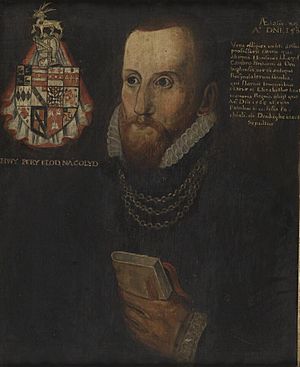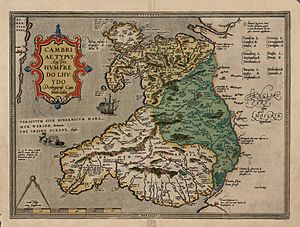Humphrey Llwyd facts for kids
Quick facts for kids
Humphrey Llwyd
|
|
|---|---|
 |
|
| Born | 1527 Denbigh, county Denbighshire, Wales
|
| Died | August 31, 1568 (aged 40–41) Denbigh
|
| Occupation | Welsh cartographer, author, antiquary |
| Office | Minister to Parliament in Elizabeth I's 1st Parliament (1559) and 2nd Parliament (1563) |
Humphrey Llwyd (1527–1568) was an important Welsh scholar. He was a cartographer, which means he made maps. He was also an author, writing books, and an antiquary, someone who studies old things and history. He was also a Member of Parliament.
Llwyd was a key figure during the Renaissance in Wales. This was a time of great new ideas in art, science, and learning. His personal library, along with books from his friends, later became part of the Royal Collection of books. These books are now kept at the British Library. Humphrey Llwyd's motto was: "Fame lasts longer than wealth."
Contents
Early Life and Education
Humphrey Llwyd was born in 1527 at Foxhall, his family's home in Denbigh, Wales. His father was Robert Llwyd.
As a young man, Llwyd went to Brasenose College, Oxford University. He was very good at science and engineering. Because of his skills, he became a doctor for the Earl of Arundel. The Earl was in charge of the university at that time.
Political Career
In 1559, Humphrey Llwyd became a Member of Parliament (MP). He represented a place called East Grinstead in Elizabeth I's first Parliament.
In 1563, Llwyd moved back to Denbigh. He lived at Denbigh Castle with permission from Sir John Salusbury. That same year, he was chosen to be an MP for Denbigh Boroughs in Elizabeth I's second Parliament. Some people think he helped pass a law to translate the Bible into Welsh, but there is no clear proof of this.
Travels and Mapmaking
From 1566, Llwyd traveled around Europe. He visited cities like Brussels, Milan, and Venice. In Antwerp, he met and worked with a famous mapmaker named Abraham Ortelius.
In 1567, Llwyd returned to Denbigh. The Queen's government gave him money to create the first printed map of Wales. This map was for Ortelius's big book of maps called Theatrum Orbis Terrarum. Even though Llwyd's map had some small mistakes, it was a groundbreaking work. It was used by many people for a long time, even into the 1700s.
Later Life and Death
Sadly, Humphrey Llwyd did not live to see his map published. He died in Denbigh on August 31, 1568. He is buried in St. Marcella's Church, which is also known as Whitchurch. The church is on the edge of Denbigh, on the road to Llandyrnog.
Lasting Impact
In 2019, a special exhibition about Humphrey Llwyd was held. It was called "Inventor of Britain" and took place at the National Library of Wales in Aberystwyth.
Written Works
Humphrey Llwyd wrote several important works. Here are some of them:
- An Almanacke and Kalender (An almanac and calendar with moon phases and planet information).
- Cronica Walliae a Rege Cadwalader ad annum 1294 (1559) (An English version of an old Welsh history book).
- De Mona druidum insula … epistola (1568) (A letter to Ortelius, published in his map book).
- Commentarioli Britannicae descriptionis fragmentum (1568). In this work, he used the term "British Empire" for the first time.
- Cambriae Typus (1568) (His famous map of Wales, published in Ortelius's book).
- Angliae regni florentissimi nova descriptio (A map of England and Wales, also published in Ortelius's book).
Llwyd also wrote two known works in the Welsh language.




